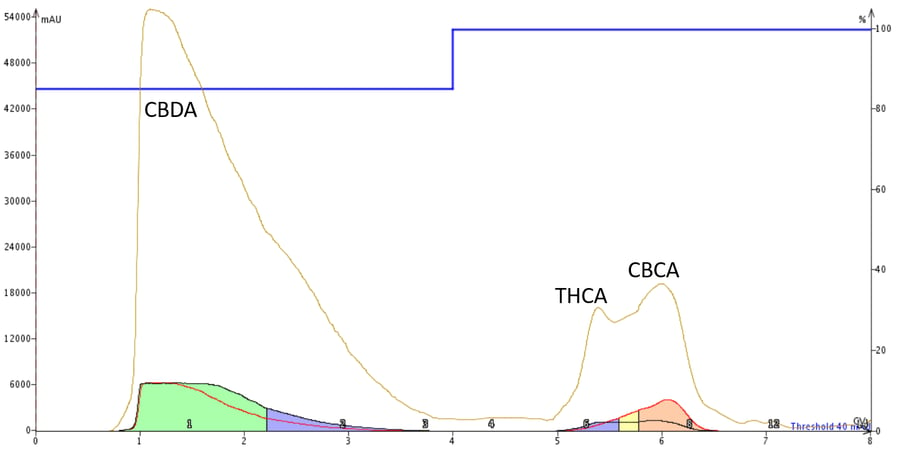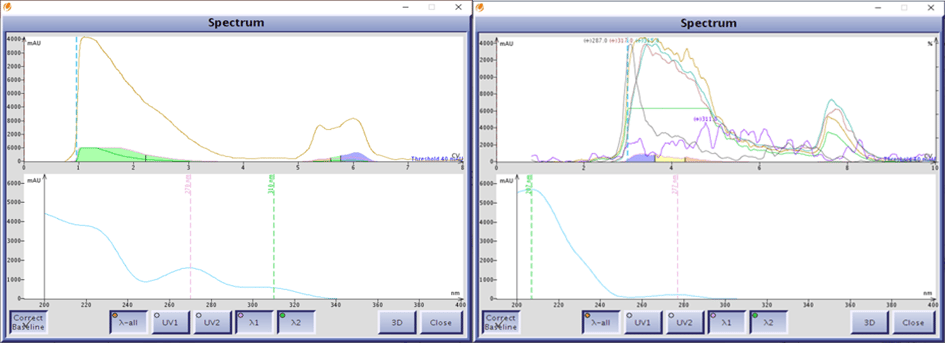Cannabidiolic acid, or CBDA, has purported analgesic properties relieving pain and inflammation[1]. CBDA is also the starting material for CBD which is produced through a procedure called decarboxylation using heat but which can also degrade CBD generating yield losses[2].
Potential CBD yield recovery may improve by first isolating pure CBDA. Though CBDA is a solid and can be isolated though crystallization processes, yield losses occur in this step as well requiring multiple iterative steps. So, to reduce purification time and increase isolation efficiency, flash chromatography can be utilized.
Like CBD, CBDA is one of the most polar cannabinoids and elutes early during reversed-phase chromatography. This is an advantage as other, more lipophilic neutral and acidic cannabinoids will be better retained on the column.
The purification protocol is the same as used for THC remediation, a simple 70-100% ethanol in water or 85-100% methanol in water step gradient created by either a Biotage® Selekt or Isolera™ LS system with a Biotage® Sfär C18 flash column, Figure 1.

Figure 1. Reversed-phase flash purification of a winterized, non-decarboxylated hemp extract provided a complete separation of CBDA from other cannabinoid acids.
How can you tell the acid form from the neutral form? Using the flash chromatography system’s PDA-UV detection system (photo-diode array ultraviolet). You may be wondering why UV light is used to detect cannabinoids. It is because most organic compounds' chemical structure incorporate one or more 'functional" groups, many which actually absorb UV light. Because UV light is absorbed by the compounds, chromatography systems measure the amount of UV light being absorbed during the purification. When a compound that absorbs UV passes through the UV light beam, the amount of absorption is displayed on the graph displayed on the touch screen.
Because most cannabinoids absorb UV light at different wavelengths, their individual UV spectra can be used to help distinguish one cannabinoid from another. This same information is useful in determining is a cannabinoid is an acid or a neutral since acid forms have different UV spectra than their neutral decarboxylation products (UV absorbance above 300 nanometers). In the case of CBDA, it has four distinctive UV maxima at 200 nm, 222 nm, 270 nm, and 310 nm while CBD has UV maxima at 207 nm and 275 nm, Figure 2.

Figure 2. UV spectra comparison of CBDA (left) and CBD (right).The CBDA spectrum is different from CBD showing four UV maxima vs. two for CBD.
This flash chromatography process provides a 1-step CBDA purification process rather than the multiple steps required using crystallization, saving time and human resources.
Interested in learning more about cannabis purification? Please download our whitepaper - A Guide to Flash Chromatography Methods for Isolating Cannabinoids.
[1] https://www.leafly.com/news/cbd/what-is-cbda-cannabidiolic-acid-marijuana-cannabinoid
[2] Wang, et al.; Cannabis and Cannabinoid Research 2016, 1.1 http://online.liebertpub.com/doi/10.1089/can.2016.0020

 Organic Workflow
Organic Workflow Peptide Workflow
Peptide Workflow Scale-Up Flash Purification
Scale-Up Flash Purification  Sample Preparation
Sample Preparation Biomolecule Purification
Biomolecule Purification Oligo synthesis
Oligo synthesis Scavengers and Reagents
Scavengers and Reagents Service & Support
Service & Support Accessories & Spare parts
Accessories & Spare parts Investors
Investors Reports & News
Reports & News The Share
The Share Corporate Governance
Corporate Governance Calendar
Calendar Sustainability
Sustainability Our Offering
Our Offering Our History
Our History Our Locations
Our Locations Leadership
Leadership